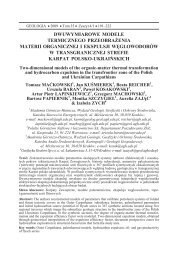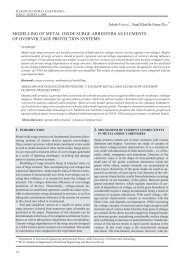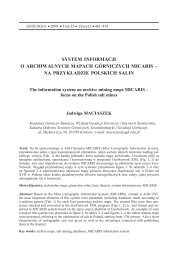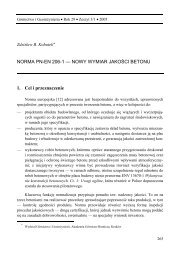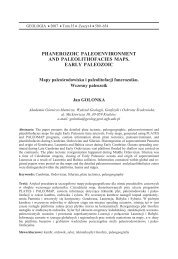Create successful ePaper yourself
Turn your PDF publications into a flip-book with our unique Google optimized e-Paper software.
136 J. Wachowiak, M. Pawlikowski & P. Wilkosz<br />
with grey clay substance; it occurred in a dispersed form between halite blasts and created<br />
clay-salt concentrations about a dozen of millimetres thick (Fig. 7A, B). The rock contained<br />
single blasts of red halite, with the diameter of 2–10 mm. Insoluble part content amounted<br />
to 14.7%. Granulometric distribution of the residue was uneven, with a small domination of<br />
a coarse fraction in which clay-sand aggregates with the diameter of up to 2 cm (Tab. 1) were<br />
the main components. In smaller fractions of < 0.6 mm, in addition to the dominating polymineral<br />
sulphate-carbonate-clay debris, binocular magni er revealed the presence of monocrystal<br />
anhydrite, magnesite, quartz, pyrite, and calcite. Chlorite and illite were identi ed in<br />
the clay fraction under an X-ray study. Anhydrite, constituting 15–20% of the residue mass,<br />
created subhedrally developed crystals, in the form of poles and slats, mostly 0.1–0.6 mm in<br />
size. Magnesite occurred in the proportion of 1–2%, also in the form of subhedrally shaped<br />
crystals, in the size of 0.05–0.5 mm and with yellow-brownish colour. Quartz constituted up<br />
to 2% of insoluble residue. Allogenic and authigenic forms of that mineral were identi ed.<br />
Authigenic, euhedrally shaped quartz crystals, in the form of a hexagonal pole ended with bipyramids,<br />
were poorly transparent, white or grey-yellowish, with the dimensions of 0.05–0.6<br />
mm. Allogenic quartz, with the grain diameter of less than 0.05 mm, occurred in a dispersed<br />
form in the salt-clay mass, often on the edges of clay and halite blast aggregates, as well as<br />
a component of clay-quartz clasts in which quartz aggregates reminded rather fragments of<br />
quatzites than sand rocks, in respect of their structures (shape and grain packing).<br />
Zuber from the depth of 1,113 m (sample 9/1113) was found in the same lithostratigraphic<br />
sequence, as that at the depth of 863 m. At the bottom, zuber was adjacent tectonically,<br />
in a discontinuous manner, to an anhydrite layer, while in the ceiling, it smoothly<br />
changed into orange-pink salt, with clay salt layers. It was composed of white-greyish, orange<br />
and light brownish salt and grey and red-brownish clay. Halite blasts had the dimensions<br />
from 1 mm to 30 mm, and they were often red-brownish in colour. Crystals with a chevron<br />
structure and several centimetre large brous halite inserts were found. Clay substance<br />
was dispersed between halite blasts and it created concentrations with the diameter from<br />
1 mm to 15 mm. X-ray analysis of grey and red-brownish clay concentrations indicated that<br />
they were composed of similar minerals: chlorite, illite, quartz, anhydrite, and halite (Fig. 8).<br />
Fig. 7. A) Halite blasts surrounded by silt-carbonate substance in zuber, Pol. 1. B) Halite blasts<br />
surrounded by silt-carbonate substance in zuber, Pol. X. C) Directionally laid anhydrite blasts with carbonate<br />
laminas, Pol. X. D) Euhedral anhydrite crystal in halite, Pol. X. E) Anhydrite blasts, with<br />
carbonate-clay lamina in anhydrite, Pol. 1. F) Parallel elongated blasts/crystals at the contact area of<br />
anhydrite and rock salt, Pol. X. A – Anhydrite, H – Halite, C – Carbonates, CQC – Aggregates: clay<br />
minerals-quartz-carbonates.<br />
(Note: Thin scratches on crystal surfaces are artefacts of sample grinding)<br />
Fig. 7. A) Blasty halitu otoczone substancj ilasto-wglanow w zubrze, Pol. 1. B) Blasty halitu<br />
otoczone substancj ilasto-wglanow w zubrze, Pol. X. C) Kierunkowo uoone blasty anhydrytu<br />
z laminami wglanowymi, Pol. X. D) Euhedralny kryszta anhydrytu w halicie, Pol. X. E) Blasty<br />
anhydrytu z lamin wglanowo-ilast w skale anhydrytowej, Pol. 1. F) Równolegle uoone, wyduone<br />
blasty/krysztay anhydrytu na kontakcie anhydrytu i soli kamiennej, Pol. X. A – anhydryt, H – halit,<br />
C – wglany, CQC – agregaty ilasto-kwarcowo-wglanowe.<br />
(Uwaga: Cienkie rysy na powierzchniach krysztaów to artefakty po szlifowaniu próbki)



